1996 BUICK REGAL key
[x] Cancel search: keyPage 154 of 356
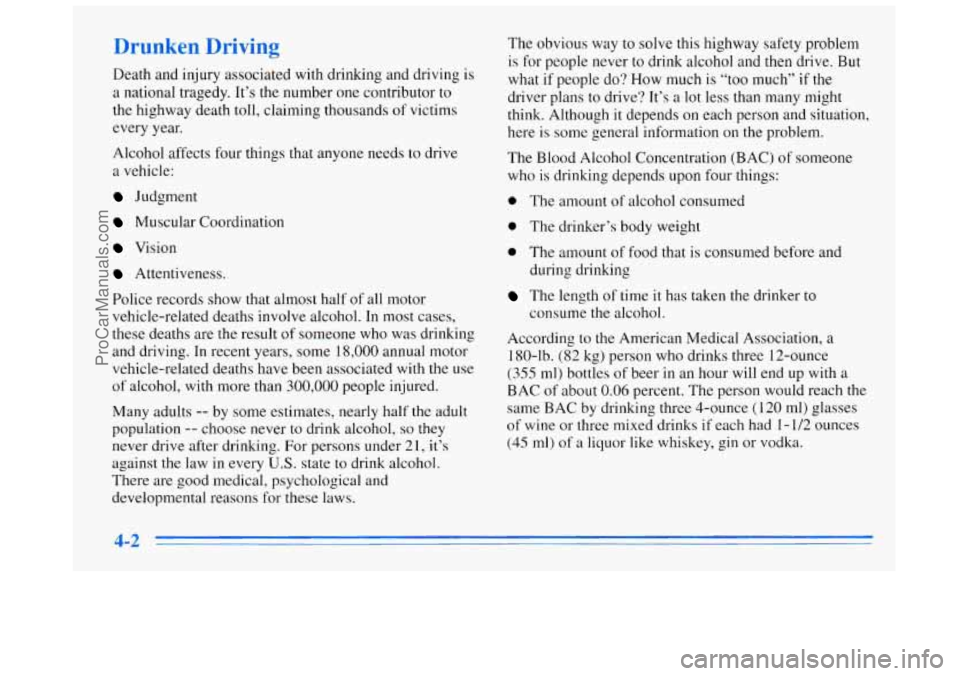
Drunken Driving
Death and injury associated with drinking and driving is
a national tragedy. It’s the number one contributor to
the highway death toll, claiming thousands of victims
every year.
Alcohol affects four things that anyone needs to drive
a vehicle:
Judgment
Muscular Coordination
Vision
Attentiveness.
Police records show that almost half of all motor
vehicle-related deaths involve alcohol. In most cases,
these deaths are the result of someone who was drinking
and driving. In recent years, some
18,000 annual motor
vehicle-related deaths have been associated
with the use
of alcohol, with more than
300,000 people injured.
Many adults
-- by some estimates, nearly half the adult
population
-- choose never to drink alcohol, so they
never drive after drinking. For persons under 21, it’s
against the law in every
U.S. state to drink alcohol.
There are good medical, psychological and
developmental reasons for these laws. The
obvious way to solve this highway safety problem
is for people never to drink alcohol and then drive. But
what if people do? How much is “too much”
if the
driver plans to drive? It’s
a lot less than many might
think. Although
it depends on each person and situation,
here is some general information on the problem.
The Blood Alcohol Concentration (BAC) of someone
who
is drinking depends upon four things:
0 The amount of alcohol consumed
0 The drinker’s body weight
0 The amount of food that is consumed before and
during drinking
The length of time it has taken the drinker to
consume
the alcohol.
According to the American Medical Association,
a
180-lb. (82 kg) person who drinks three 12-ounce
(355 ml) bottles of beer in an hour will end up with a
BAC of about 0.06 percent. The person would reach the
same BAC by drinking three 4-ounce (120 ml) glasses
of wine or three mixed drinks if each had 1 - 1/2 ounces
(45 ml) of a liquor like whiskey, gin or vodka.
4-2
ProCarManuals.com
Page 189 of 356
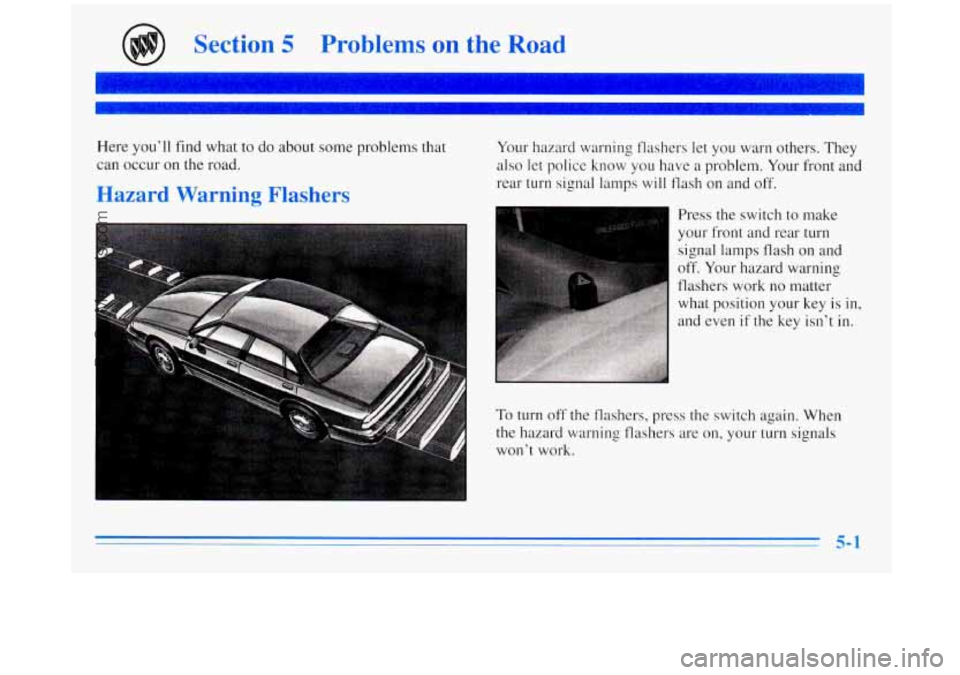
Section 5 Problems on the Road
Here you’ll find what to do about some problems that
can occur
on the road.
Hazard Warning Flashers
Your hazard warning flashers let you warn others. They
also let police know you have a problem. Your front
and
rear turn signal lamps will flash on and off.
Press the switch to make
your front and rear turn
signal lamps flash on and
off. Your hazard warning
flashers work no matter
what position your key is
in,
and even if the key isn’t in.
To turn off the flashers, press the switch again. When
the hazard warning flashers are on, your turn signals
won’t work.
5-1
ProCarManuals.com
Page 196 of 356
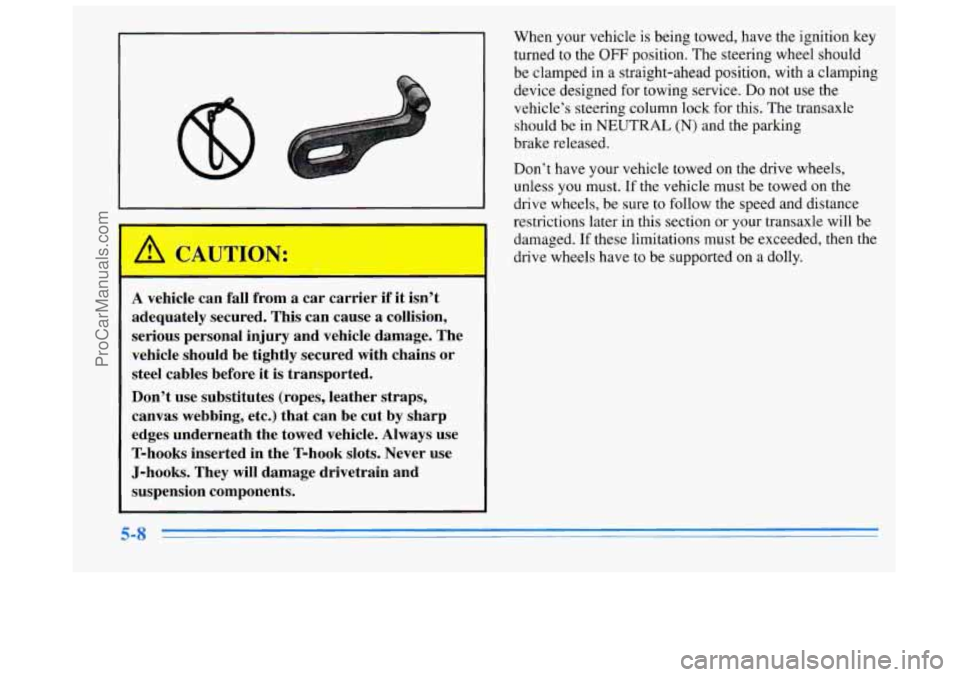
A V
A vehicle can fall from a car carrier if it isn’t
adequately secured. This can cause a collision,
serious personal injury and vehicle damage. The
vehicle should be tightly secured with chains or
steel cables before it is transported.
Don’t use substitutes (ropes, leather straps,
canvas webbing, etc.) that can be cut by sharp
edges underneath the towed vehicle. Always use
T-hooks inserted in the T-hook slots. Never use
J-hooks. They will damage drivetrain and
suspension components.
When your vehicle is being towed, have the ignition key
turned to the
OFF position. The steering wheel should
be clamped in a straight-ahead position, with a clamping
device designed for towing service.
Do not use the
vehicle’s steering column lock for this. The transaxle
should be in
NEUTRAL (N) and the parking
brake released.
Don’t have your vehicle towed on the drive wheels,
unless you must.
If the vehicle must be towed on the
drive wheels, be sure to follow the speed and distance
restrictions later in this section or your transaxle will be
damaged.
If these limitations must be exceeded, then the
drive wheels have
to be supported on a dolly.
3
ProCarManuals.com
Page 322 of 356
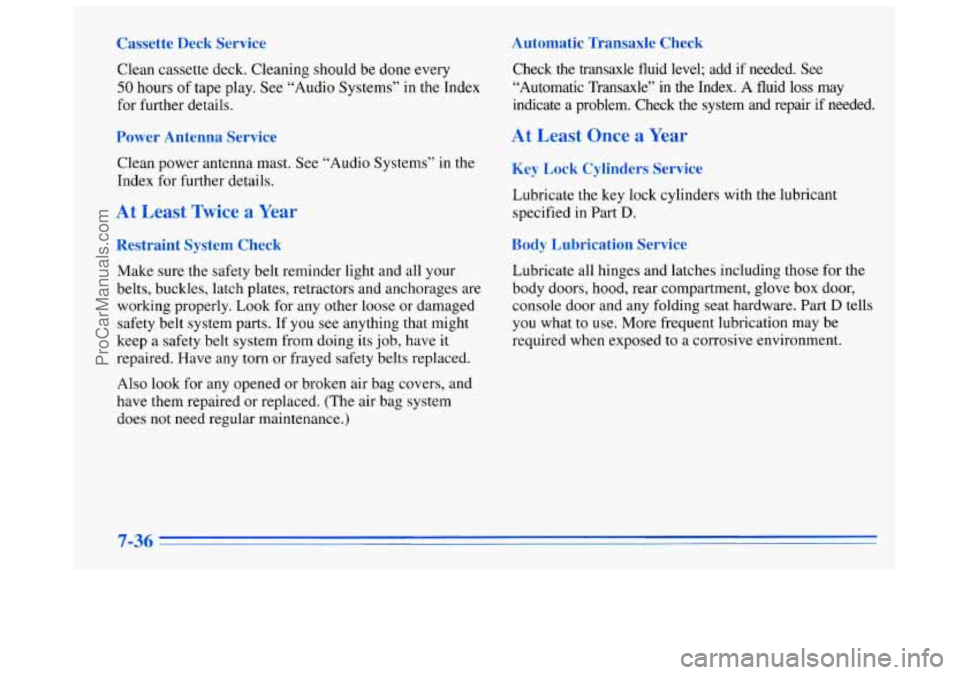
Cassette Deck Service Automatic Transaxle Check
Clean
cassette deck. Cleaning should be done every
50 hours of tape play. See “Audio Systems’’ in the Index
for further details.
Power Antenna Service
Clean power antenna mast. See “Audio Systems” in the
Index for further details.
At Least Twice a Year
Restraint System Check
Make sure the safety belt reminder light and all your
belts, buckles, latch plates, retractors and anchorages are
working properly. Look for any other loose or damaged
safety belt system parts. If you see anything that might
keep a safety belt system from doing its job, have it
repaired. Have any torn or frayed safety belts replaced.
Also look for any opened or broken air bag covers, and
have them repaired or replaced. (The air bag system
does
not need regular maintenance.) Check the transaxle fluid level; add if needed.
See
“Automatic Transaxle”
in the Index. A fluid loss may
indicate a problem. Check the system and repair if needed.
At Least Once a Year
Key Lock Cylinders Service
Lubricate the key lock cylinders with the lubricant
specified
in Part D.
Body Lubrication Service
Lubricate all hinges and latches including those for the
body doors, hood, rear compartment, glove box door,
console door and any folding seat hardware. Part
D tells
you what to use. More frequent lubrication may be
required when exposed
to a corrosive environment.
7-36
ProCarManuals.com
Page 323 of 356
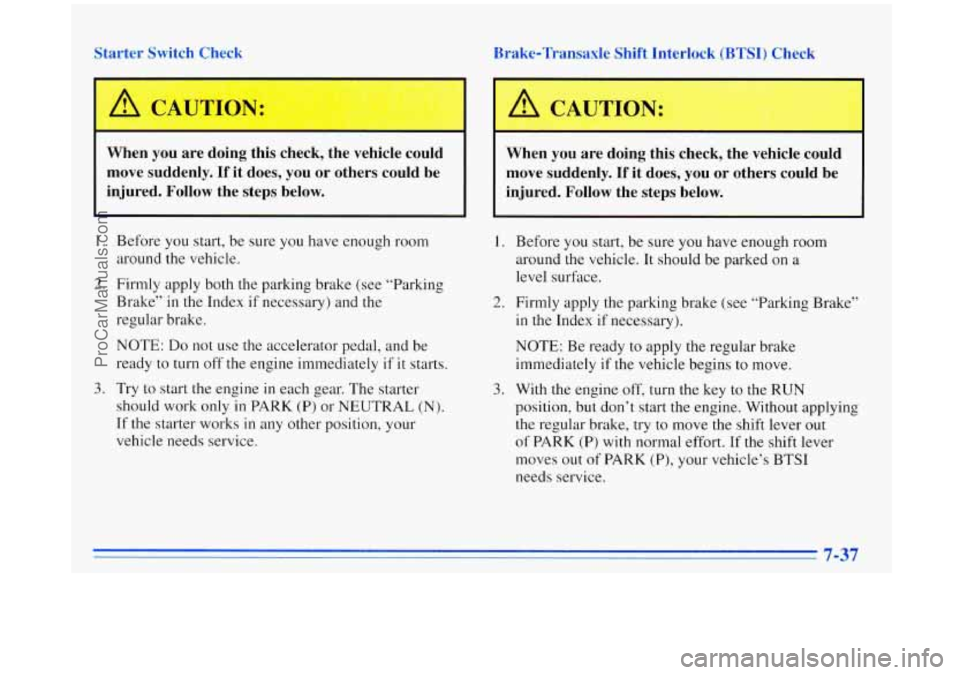
Starter Switch Check Brake-Transaxle Shift Interlock
(BTSI) Check
A CAUTION:
IF
When you are doing this check, the vehicle could
When you are doing this check, the vehicle could
move suddenly. If it does, you or others could be
move suddenly. If it does, you or others could be
injured. Follow the steps below. injured. Follow the steps below.
1. Before you start, be sure you have enough room
around the vehicle.
2. Firmly apply both the parking brake (see “Parking
Brake”
in the Index if necessary) and the
regular brake.
NOTE:
Do not use the accelerator pedal, and be
ready to
turn off the engine immediately if it starts.
3. Try to start the engine in each gear. The starter
should work only
in PARK (P) or NEUTRAL (N).
If the starter works in any other position, your
vehicle needs service.
1. Before you start, be sure you have enough room
around
the vehicle. It should be parked on a
level surface.
2. Firmly apply the parking brake (see “Parking Brake’’
in the Index if necessary).
NOTE: Be ready to apply the regular brake
immediately
if the vehicle begins to move.
3. With the engine off, turn the key to the RUN
position, but don’t start the engine. Without applying
the regular brake, try to move the shift lever out
of PARK (P) with normal effort. If the shift lever
moves out
of PARK (P), your vehicle’s. BTSI
needs service.
7-37
ProCarManuals.com
Page 324 of 356
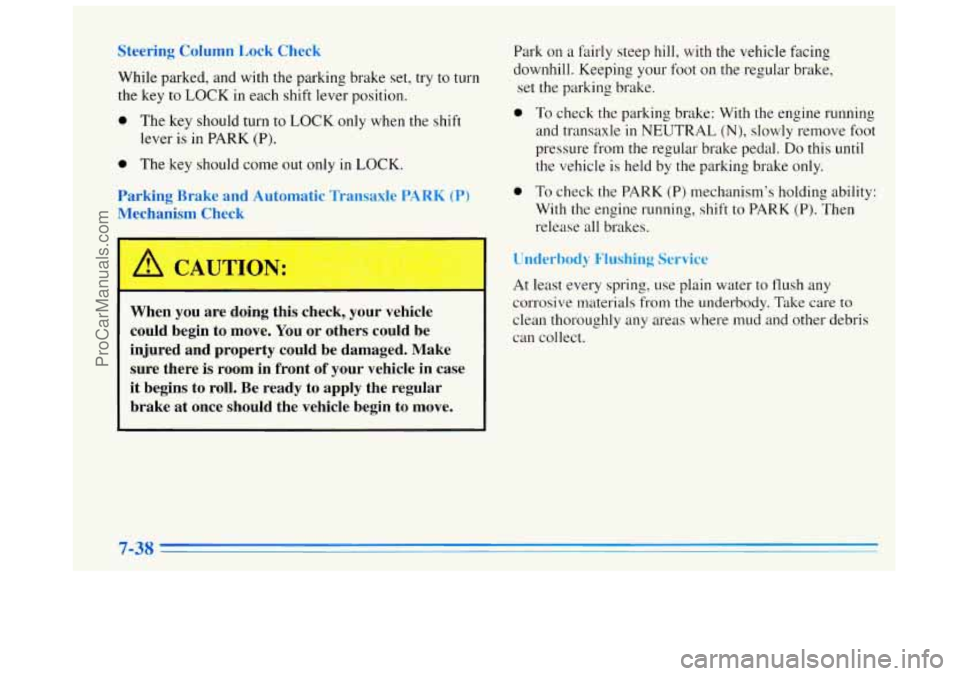
Steering Column Lock Check While parked, and with the parking brake set, try to turn
the key to
LOCK in each shift lever position.
0 The key should turn to LOCK only when the shift
lever is
in PARK (P).
0 The key should come out only in LOCK.
Parking Brake
and Automatic Transaxle PARK (P)
Mechanism Check
When you are doing this check, your vehicle
could begin to move.
You or others could be
injured and property could be damaged. Make
sure there is room in front
of your vehicle in case
it begins to roll. Be ready to apply the regular
brake at once should the vehicle begin to move. Park
on a
fairly steep hill, with the vehicle facing
downhill. Keeping your foot on the regular brake,
set the parking brake.
0 To check the parking brake: With the engine running
and transaxle
in NEUTRAL (N), slowly remove foot
pressure from the regular brake pedal.
Do this until
the vehicle
is held by the parking brake only.
0 To check the PARK (P) mechanism's holding ability:
With the engine running, shift to PARK (P). Then
release all brakes.
Underbody
Flushing Service
At least every spring, use plain water to flush any
corrosive materials from
the underbody. Take care to
clean thoroughly any areas where mud and other debris
can collect.
7-38
-~
ProCarManuals.com
Page 326 of 356
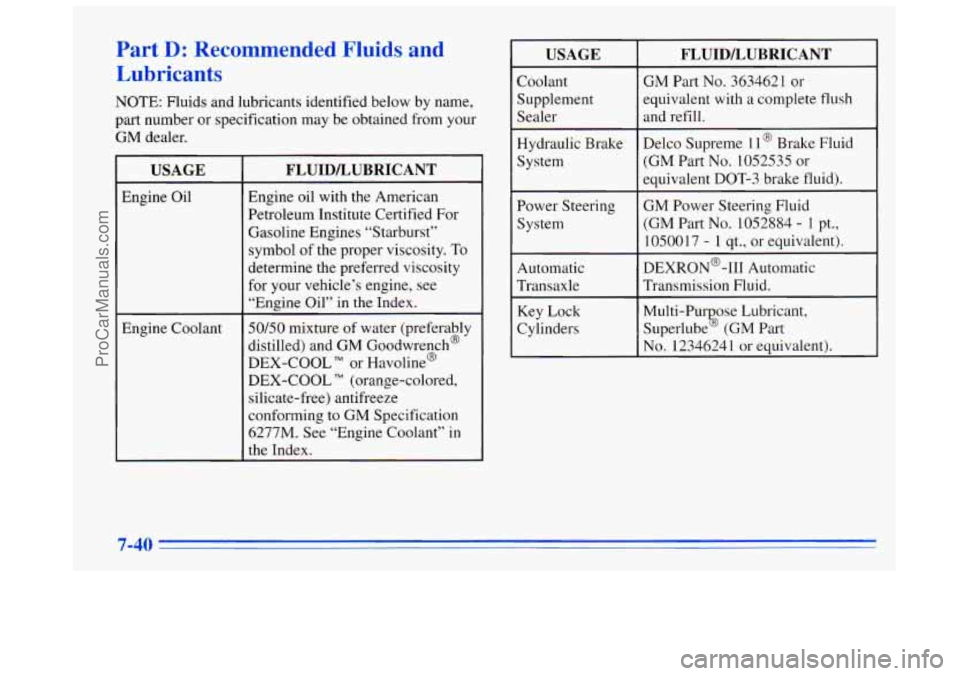
Part D: Recommended Fluids and
Lubricants
NOTE: Fluids and lubricants identified below by name,
part number or specification may be obtained from your
GM dealer.
USAGE
Engine Oil
Engine Coolant
FLUIDLUBRICANT
Engine oil with the American
Petroleum Institute Certified For Gasoline Engines “Starburst”
symbol of the proper viscosity. To
determine the preferred viscosity
for your vehicle’s engine, see
“Engine Oil” in the Index.
50/50 mixture of water (preferably
distilled) and
GM Goodwrench@
DEX-COOL
TM or Havoline@
DEX-COOL (orange-colored,
silicate-free) antifreeze
conforming
to GM Specification
6277M. See “Engine Coolant” in
the Index.
USAGE
Coolant
Supplement
Sealer
Hydraulic Brake
System
Power Steering
System
Automatic
Transaxle
Key Lock
Cylinders
FLUIDLUBRICANT
GM Part No. 3634621 or
equivalent with a complete flush
and refill.
Delco Supreme 11
@ Brake Fluid
(GM Part No. 1052535 or
equivalent
DOT-3 brake fluid).
GM Power Steering Fluid (GM Part
No. 1052884 - 1 pt.,
1050017 - 1 qt., or equivalent).
DEXRON@-111 Automatic
Transmission Fluid.
Multi-Pur ose Lubricant,
Superlube
b (GM Part
, No. 1234624 1 or equivalent).
ProCarManuals.com
Page 345 of 356

(@ Section 9 Index
I- .I
Accessory Outlet .............................. 2-4 I
AirBag ....................................... 1-18
How Does it Restrain .......................... 1-22
How
it Works ................................ 1-20
Location
.................................... 1-20
Readiness Light
......................... 1 . 19. 2.47
Servicing
................................... 1-23
What Makes
it Inflate .......................... 1-2 1
What Will You See After it Inflates ............... 1-22
When Should
it Inflate ......................... 1-21
AirCleane
r .................................... 6-16
Air Conditioning
................................ 3-3
Alarm, Theft-Deterrent ........................... 2-8
Alignment and Balance. Tire
...................... 6-40
Aluminum Wheels, Cleaning
...................... 6-48
Antenna, Fixed
................................. 3-26
Antenna, Power
................................ 3-26
Antifreeze ................................... 6-20
Anti-Lock Brake System Active Light
................. 2-50.4-8
Brake System Warning Light
................ 2-49.4-6
Brakes
...................................... 4-6
Anti-Theft, Radio
.............................. 3-2 I
Appearance Care ............................... 6-42
Air Conditioning Refrigerants ..................... 6-63 Appearance Care Materials
....................... 6-50
Arbitration Program
.............................. 8-6
Armrest. Storage
............................... 2-38
Ashtrays
...................................... 2-40
Astroroof
..................................... 2-42
Audio Controls
. Steering Wheel Touch Control ....... 3-23
Audio Equipment. Adding
........................ 3-24
Audio Systems
.................................. 3-6
Auto-Down Window
............................ 2-25
Automatic DoorLocks
................................... 2-4
Overdrive
. Automatic Transaxle ................. 2-16
Shifting ..................................... 2-14
Transaxle Check
.............................. 7-36
Transaxle Fluid
............................... 6-17
Transaxle Park Mechanism Check ................ 7-38
Battery
...................................... 6-30
J~np Starting ................................. 5-2
Saver
...................................... 2-36
Warnings
................................ 5.2. 5.4
BBB Auto Line
................................. 8-6
Better Business Bureau Mediation
................... 8-6
Replacement. Remote Keyless Entry ............... 2-5
9-1
ProCarManuals.com